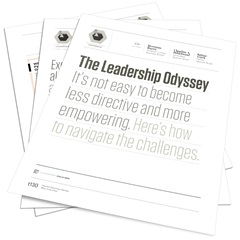 Now featured in HBR’s 10 Must Reads on Emotional Intelligence 2025
Now featured in HBR’s 10 Must Reads on Emotional Intelligence 2025
Leaders at the top need to empower their teams using a more people-centric leadership style. But transitioning from the more directive style they used earlier in their careers is harder than it seems. Here's what our research finds about the journey.
Executives have always been — and always will be — expected to produce results. But today they’re expected to produce them in a fundamentally different way. Gone are the days of the heroic individual leading from the front. Instead, in most corporations, decision-making has become decentralized, and leaders are now supposed to empower and enable their people. This requires people skills — often described as “soft skills” — that many executives have not had to hone on their rise to the top.
Leaders often rise through the ranks by employing a directive style, but they’re suddenly expected to become more empowering when they move into top-level positions. Most have a hard time adapting.
Executives who decide to shift styles need to recognize that the transformation will be long and difficult — an odyssey requiring humility, self-awareness, patience and resilience. Broadening your repertoire of people skills is not a single event but an involved process that unfolds over time, often uncomfortably, in three predictable stages:
- The departure — the first stage, when a leader recognizes the need for a change and deliberately starts to leave behind familiar ways of working
- The voyage — a time of transition when the leader encounters obstacles and trials that teach important lessons and open the path to transformation
- The return — a period during which leaders arrive at a new understanding of who they are and what kind of leader they want to be and start to transfer what they’ve learned to others
In this article, we highlight the three main stages of this journey and tips for succeeding in your own journey.
